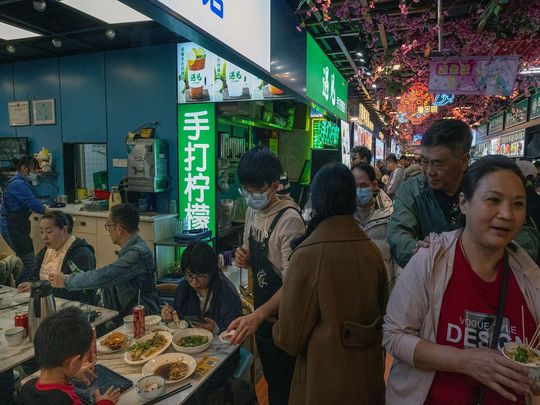
Chinese tourists spent more per trip over a holiday than in 2019 for the first time since the pandemic started, adding to signs that consumption is recovering in the world’s No. 2 economy.
Travelers spent nearly 54 billion yuan ($7.5 billion) on 119 million trips within the country during the recent three-day break, the Ministry of Culture and Tourism said in a statement.
That works out to some 453 yuan per trip, up 1.1 per cent from 2019. Goldman Sachs Group Inc. and Citigroup Inc. said this marks the first time that per-trip holiday spending has topped pre-pandemic levels.
The travel data adds to signs that recovering consumption sentiment may give the economy some extra help after three years of harsh rules intended to curb the spread of Covid-19. Before the break, China reported data that showed factory activity exceeded expectations in March, boosting optimism the country can achieve its ambitious growth goal of around 5 per cent this year.
“This indicates that household tourist consumption potential and willingness were released fully,” China Greatwall Securities Co. analysts including Jiang Fei wrote in a note dated Monday. “We expect services expenditure as a share of total consumption will increase further this year, driving the recovery of household consumption to some extent.”
Chinese shares listed in Hong Kong fluctuated on Monday after a two-session slide, and China’s CSI 300 Index slipped 0.4 per cent as it trades near the highest since mid-March.
To be sure, a full recovery in Chinese travelers’ spending has yet to materialize. The number of domestic trips during the recent holiday rose 11.5 per cent compared to 2019 versus the 19 per cent jump seen over the Lunar New Year break in February, Goldman Sachs economist Hui Shan wrote in a note on Sunday.
That indicated the “unusual strength” during the Lunar New Year spending was partially driven by pent-up demand for family reunions, she said.
The Tourism Ministry said in its statement on Saturday that travelers favored short jaunts to city suburbs and tourist spots close to home. Local authorities tried to make the most of their opportunities, providing special public transport, organizing events such as food festivals and extending the hours of scenic spots.
Tianshui, a city in northwestern China that’s become known for its street food, was among the most popular tourist destinations over the recent Qingming Festival, also known as Tomb-Sweeping Day. Tongcheng Travel Holdings, a travel website, said the city of 2.9 million people topped a gauge that incorporated a range of factors, including hotel bookings and searches.
Chinese tourists also stepped up foreign travel over the recent holiday. They made 2.42 million cross-border trips, up 102 per cent from 2023, according to National Immigration Administration. The break last year was just one day.
Foreigners made 500,000 trips across the border, it said, a surge of 163 per cent. China has been trying to attract foreign visitors recently, allowing visa-free entry for travelers from a growing list of countries and making digital payments easier to use.








